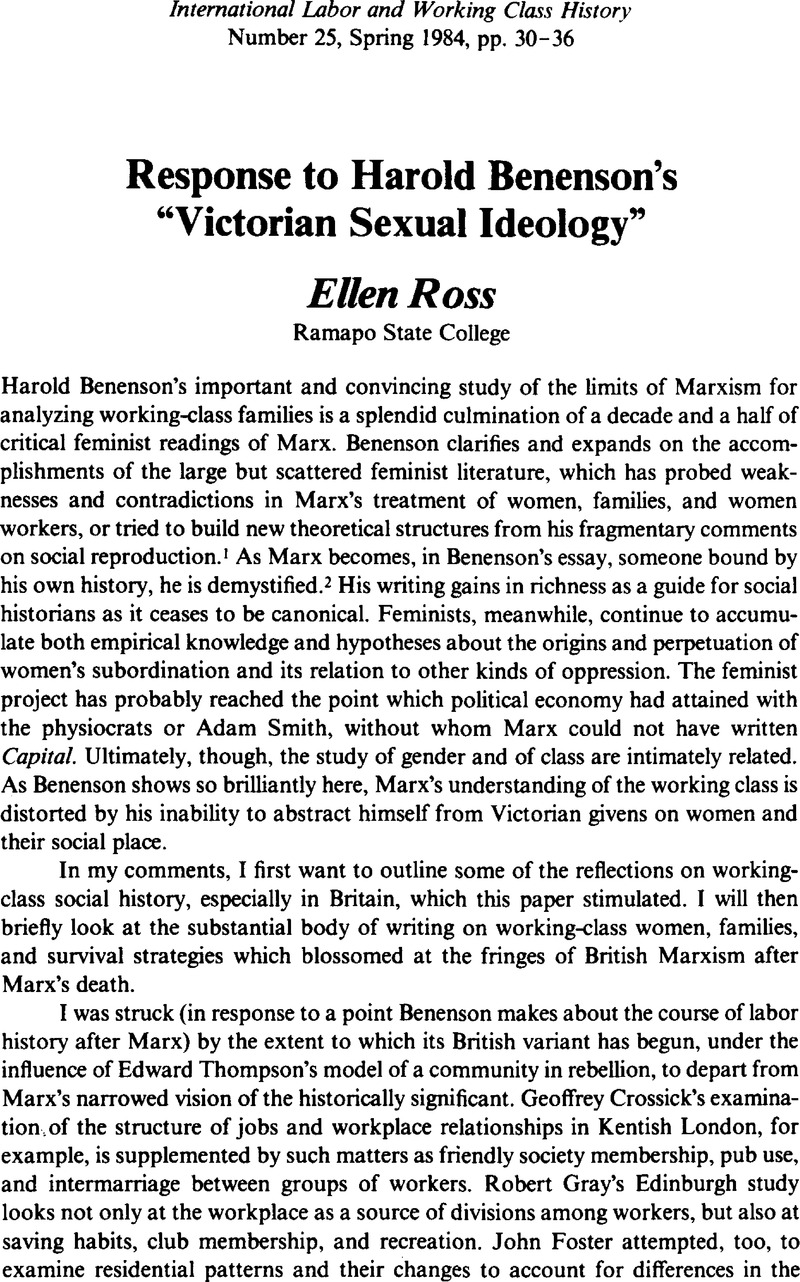No CrossRef data available.
Published online by Cambridge University Press: 16 December 2008

1. For very good footnote references see:Bridenthal, Renate “The Family: The View From a Room of Her Own,” in Rethinking the Family, ed. Thorne, Barrie with Yalom, Marilyn (New York: Longman, 1982), p. 238, n.26;Google Scholar and Petchesky, Rosalind Pollack, “Reproduction and Class Divisions Among Women,” in Class, Race, and Sex: the Dynamics of Control, ed. Swerdlow, Amy and Lessinger, Hanna (Boston: G.K. Hall & Co., 1983), pp. 237–39, n. 6, n. 10, n. 22Google Scholar.
2. Another wonderfully successful attempt to view Marx historically is Samuel, Raphael, “British Marxist Historians, 1880–1980: Part One,” New Left Review 120 (03–04 1980). 21–95. 21–95Google Scholar.
3. In addition to those named above, see: Joyce, Patrick, Work, Society and Politics: The Culture of the Factory in Later Victorian England (Brighton: Harvester Press, 1980)Google Scholar; and Willis, Paul, “Shop Floor Culture, Masculinity and the Wage Form,” in Working-Class Culture. Studies in History and Theory, ed. Clarke, John, Crichter, Chas. and Johnson, Richard (London: Hutchinson, 1979)Google Scholar.
4. A good “position paper” on married women's work is Alexander, Sally, Davin, Anna and Hostettler, Eve, “Labouring Women: A Reply to Eric Hobsbawm,” History Workshop 8 (Autumn 1979): 174–182Google Scholar.
5. I have written more about the strike and its relation to London family economies in “‘Fierce Questions and Taunts’: Married Life in Working-Class London, 1870–1914,” Feminist Studies 8, no. 3 (Fall 1982): 575–602Google Scholar.
6. Pfautz, Harold W., “The Times, the Man, and the Inquiry,” in Charles Booth on the City, ed. Pfautz, Harold W. (Chicago: University of Chicago Press, 1967), p. 17.Google Scholar The quotation is from Mary Booth's biography of her husband.
7. In addition to the well known general studies of Rowntree, Lady Bell, Butler, Bowley, and the Fabian Women's Group, there is a large literature looking directly at family budgets – for example: Collet, E. and Robertson, M., Family Budgets: Being the Income and Expenses of 28 British Households, 1891–94 (London: P.S. King & Son, 1896)Google Scholar; DrOliver, Thomas, “The Diet of Toil,” The Lancet (29 06 1895): 1629–35CrossRefGoogle Scholar; and Higgs, Henry, “Workmen's Budgets,” Journal of the Royal Statistical Society 56 (06 1893): 255–285CrossRefGoogle Scholar.
8. This discussion is based on unpublished work by Judith Walkowitz which she kindly shared with me (March 1984).
9. A very thoughtful introduction to this variant of British feminism is found in Alexander&s, Sally Introduction to Round About a Pound a Week (London: Virago Limited, 1979). The quotation is from p. xv.Google Scholar
10. Martin, Anna, Mothers in Mean Streets, or. The Toad under the Harrow (London: United Suffragists, n. d. [during World War I]), p.11Google Scholar.
11. Ibid., pp. 17–18.
12. Pankhurst, Sylvia, The Suffragette Movement (London: Virago Limited, 1977), p. 111.Google Scholar Pankhurst's account was first published in 1931.